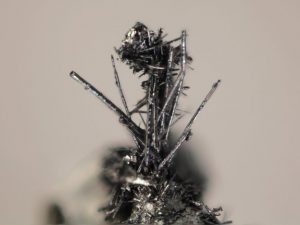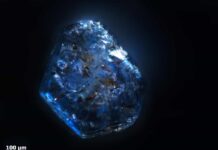
Credit: Michigan Tech, John Jaszczak
In the age of fast-paced global communication, it’s no wonder that teasing apart the anatomy of the new mineral merelaniite took a team from around the world. Most mineral discoveries start with boots on the ground—or, rather, below the ground. The Merelani mining district is a well-known locale. Not only for prized tanzanite and tsavorite used in jewelry, but also for hosting a suite of other minerals increasingly prized by mineral collectors.
“The Merelani district has been famous since the late 1960s for the blue gem variety of zoisite known as tanzanite, but this is really a mineral collector’s paradise and an exciting place to look for new minerals,” says John Jaszczak, a physics professor at Michigan Tech and the lead author on a new study published in Minerals that describes the new mineral. “The importance of the area is the reason we wanted to give tribute to the miners and name merelaniite for the district.”
There are 5,179 minerals listed by the International Mineralogical Association and their Commission on New Minerals, Nomenclature and Classification (CNMNC) receive more than 80 proposals each year for new ones. Many turn out to be variations of existing minerals. To discern the new from the variable, Jaszzak and his team put the tiny merelaniite whiskers through a battery of rigorous tests, particularly to discern its chemistry and crystal structure.
“It is one thing to find a mineral that is probably new, it is quite another thing to be able to perform all of the required analyses to satisfy the CNMNC for approval of its status and a new name,” Jaszczak says.
Atomic Details
Jaszczak teamed up with Mike Rumsey and John Spratt at the Natural History Museum in London to determine the chemical composition of the new mineral with precision. To help with understanding the crystal structure, Steve Hackney, professor of materials science at Michigan Tech, was able to provide crucial high-resolution images and diffraction patterns using transmission electron microscopy on ultrathin samples prepared with a diamond knife by Owen Mills, director of Michigan Tech’s Applied Chemical & Morphological Analysis Laboratory.
The growing team then sought out the help of Luca Bindi, a professor at the Università di Firenze in Italy and an expert in solving complicated crystals structures. He helped run x-ray diffraction studies to put all of the pieces together. The results revealed a complex structure made up of layers of molybdenum disulfide alternating at the atomic scale with layers of lead sulfide, along with other elements, including vanadium, antimony, bismuth, and selenium. The layers curve inward, growing into a scroll-like cylinder.
Although it is not a showcase gem, merelaniite is attractive, and as the analyses show, it has an intricate, microscopic internal beauty as well. A better understanding of the crystal chemistry of these exotic materials may eventually find useful applications.
Echoing physicist Richard Feynman, Jaszczak notes, “Science is about taking pleasure in finding things out and we’re delighted to have uncovered and described this beautiful new mineral.”
Reference:
The journal Minerals DOI:10.3390/min6040115
Note: The above post is reprinted from materials provided by Michigan Technological University.










